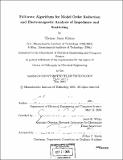| dc.contributor.advisor | Jacob K. White. | en_US |
| dc.contributor.author | Klemas, Thomas J. (Thomas Jonas) | en_US |
| dc.contributor.other | Massachusetts Institute of Technology. Dept. of Electrical Engineering and Computer Science. | en_US |
| dc.date.accessioned | 2006-08-25T18:57:02Z | |
| dc.date.available | 2006-08-25T18:57:02Z | |
| dc.date.copyright | 2005 | en_US |
| dc.date.issued | 2005 | en_US |
| dc.identifier.uri | http://hdl.handle.net/1721.1/33922 | |
| dc.description | Thesis (Ph. D.)--Massachusetts Institute of Technology, Dept. of Electrical Engineering and Computer Science, 2005. | en_US |
| dc.description | Includes bibliographical references (p. 173-178). | en_US |
| dc.description.abstract | As technology advances and sophisticated electronic systems achieve ubiquity, the demand for thorough, efficient Electromagnetic (EM) analysis continues to rise. The prohibitive costs of constructing and maintaining measurement facilities and designing and buildin-l system prototypes has fueled even greater demand for Computational Electromagnetics (CEM). Today's CEM solvers can generate models that accurately characterize the EM behavior of an arbitrary structure presented for analysis. Two important applications for CEM are Scattering analysis of targets excited by EM waves and impedance modelling for the interconnect between the electronic components in Systems on Package (SoP) and Systems on Board (SoB). Often, the goal of analysis is to characterize behavior relative to parameters of interest. and EMI solvers can generate paralneter-depenldent models of the system. The complexity of structures has increased so much that solving the solver-generated models at numerous desired parameter-points is a daunting computational task. For example, using these models in a simulator would be infeasible. | en_US |
| dc.description.abstract | (cont.) Instead, existing Model Order Reduction (MOR) algorithms can construct reduced order models (ROMs) that clharacterize the pararreter-dependent behavior of the original system. These existing methods are effective when the system of equations is linearly or weakly nonlinearly dependent on the parameters. When analyzing structures that are large compared to wavelengths of interest, retardation generates an exponentially nonlinear dependence on frequency, and such a strong nonlinearity makes it impossible to use existing MOR methods. This dissertation describes a new algorithm, Segregation by Primary Phase factors, that extends existing projection-based MIOR techniques to the case of "'Electromagnetically Large" structures. Extensions of the SPPF method to problems with parameter-dependent excitation arc considered, as well as how to combine SPPF with fast integral equation solvers. | en_US |
| dc.description.statementofresponsibility | by Thomas Jonas Klemas. | en_US |
| dc.format.extent | 178 p. | en_US |
| dc.format.extent | 9142640 bytes | |
| dc.format.extent | 9150107 bytes | |
| dc.format.mimetype | application/pdf | |
| dc.format.mimetype | application/pdf | |
| dc.language.iso | eng | en_US |
| dc.publisher | Massachusetts Institute of Technology | en_US |
| dc.rights | M.I.T. theses are protected by copyright. They may be viewed from this source for any purpose, but reproduction or distribution in any format is prohibited without written permission. See provided URL for inquiries about permission. | en_US |
| dc.rights.uri | http://dspace.mit.edu/handle/1721.1/7582 | |
| dc.subject | Electrical Engineering and Computer Science. | en_US |
| dc.title | Full-wave algorithms for model order reduction and electromagnet analysis of impedance and scattering | en_US |
| dc.title.alternative | New full-wave algorithms for model order reduction and electromagnet analysis of impedance and scattering | en_US |
| dc.type | Thesis | en_US |
| dc.description.degree | Ph.D. | en_US |
| dc.contributor.department | Massachusetts Institute of Technology. Department of Electrical Engineering and Computer Science | |
| dc.identifier.oclc | 67293886 | en_US |
